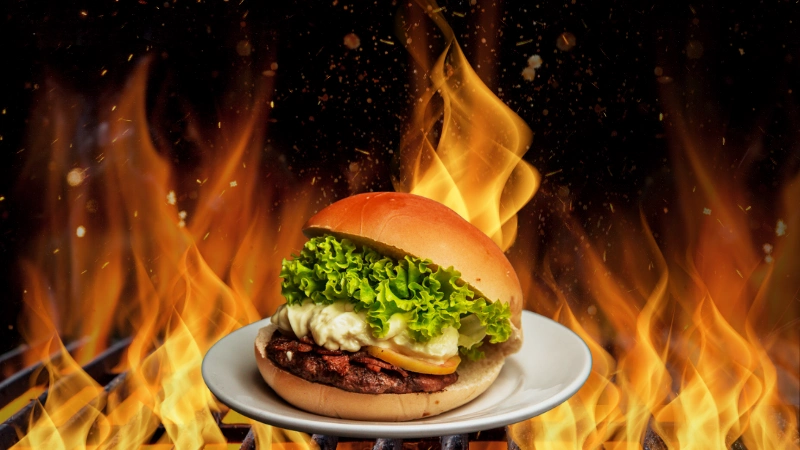Hot Plates, Hidden Risks
- Home
- Hot Plates, Hidden Risks

Hot Plates, Hidden Risks
Summer is prime time for dining under the sun—whether at outdoor patios, backyard barbecues, or roadside food stands. But this season’s warmth also brings a risk: when food is cooked or served outdoors in high heat, the chance of foodborne illness—or food poisoning—increases steeply.
Why Summer Raises the Risk
Bacteria thrive in warm, humid weather, growing most rapidly between 4 °C and 60 °C (40 °F to 140 °F)—known as the “danger zone”. In summer, food left out for more than two hours (or just one hour if temperatures exceed 32 °C/90 °F) can become hazardous. Health Canada estimates nearly 4 million foodborne illnesses per year in Canada—and summer dining habits accelerate that risk.
When restaurants or food trucks are involved, risks can be amplified. Eating out introduces potential for contaminated ingredients, inadequate refrigeration, or unsafe water sources—especially if food prep occurs off-site or in makeshift kitchens.
Common Hot-Weather Hazards
The Human Impact
Symptoms of foodborne illness include cramps, diarrhea, vomiting, fever—and they’re not limited to a bad stomach ache. Some bacteria can trigger long-term complications. Vulnerable populations—children, seniors, and individuals with compromised immunity—face greater risks.
In Canada, poor food handling outdoors is blamed for many cases each summer. In British Columbia alone, roughly 1,400 people fall ill daily due to foodborne pathogens.
Summer Dining Safety Made Simple
Here’s how to enjoy your summer meals without worry:
1. Clean Up and Wash Up
Always wash hands before eating or handling food—and use sanitizer if water isn’t available. From servers to guests, cleanliness prevents transmission.
2. Keep it Chill
Store raw ingredients and leftovers in coolers with ice packs. Never let perishable food sit unrefrigerated for more than 1–2 hours depending on heat.
3. Cook to Safe Temperatures
Use digital food thermometers—especially when grilling outdoors—to ensure meats, fish, and poultry hit safe internal temps.
4. Separate Raw & Cooked Foods
Use different utensils and plates for raw meats and ready-to-eat items. Minimize contact with shared surfaces.
5. Serve Small Batches
Refill cold or hot dishes regularly instead of leaving large platters out. Keep cold foods below 4 °C and hot foods above 60 °C.
6. Know Which Foods to Skip
Stay cautious with seafood salads, raw eggs, soft cheeses, or anything that’s been in the sun too long.
Putting Tips into Practice
At a backyard BBQ? Keep potato salads chilled, serve proteins in small portions, and cut cut fruit just before serving. Using coolers during long picnics makes a big difference.
Ordering from a street vendor? Look for busy stalls, ask about refrigeration, and avoid hot foods that have been sitting under tents for hours.
When eating at restaurants, trust your instincts: lukewarm food, improper plating, or poor hygiene practices are red flags.
The Bigger Picture
Eating out should be safe—and safe eating should thrive in the norms of summer festivities. That means treating food safety as part of good planning—whether at a picnic, patio, or festival. Governments in Canada, the Northwest Territories, and globally (through WHO and FDA) have issued seasonal guidance stressing basic precautions that still get overlooked in the heat.
Final Bite
Summer food is a pleasure—but only if served safely. By keeping temperatures in check, handling food mindfully, and staying alert to common pitfalls, you can savor every bite without unwanted outcomes. After all, summer memories taste best when they don’t come with a side of food poisoning.
References:
Health Canada. (2025, February 5). Summer food safety tips. Government of Canada. Retrieved from https://www.canada.ca/en/health-canada/services/seasonal-food-safety/summer-food-safety-tips.html Canada.ca+1World Health Organization+1Recalls and Safety Alerts+3Canada.ca+3Canada.ca+3
Government of the Northwest Territories, Health and Social Services. (n.d.). Summer food safety guidelines. Retrieved from https://www.hss.gov.nt.ca/en/services/summer-food-safety-guidelines
World Health Organization. (approx. 2 years ago). Public health advice on food safety during summer. WHO Regional Office for Europe. Retrieved from https://www.who.int/europe/news-room/fact-sheets/item/public-health-advice-on-food-safety-during-summer World Health Organization
U.S. Food and Drug Administration. (n.d.). Handling food safely while eating outdoors. Retrieved from https://www.fda.gov/food/buy-store-serve-safe-food/handling-food-safely-while-eating-outdoors
CommunityCare. (n.d.). Summer, the season of food poisoning. Retrieved from https://communitycare.com/summer-the-season-of-food-poisoning/
- Share
Magazica
Magazica is a dedicated platform for businesses, subject matter experts, health advocates, and various sectors within the health industry. At Magazica, we are committed to sharing the latest health information and developments with our audience. We serve as a gateway for health-related businesses to showcase their progress and advancements, demonstrating how they contribute to enhancing people's wellness.
